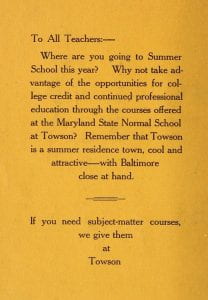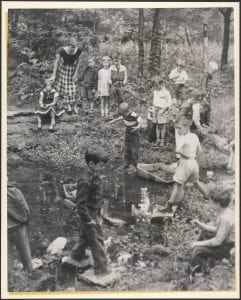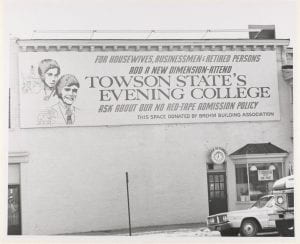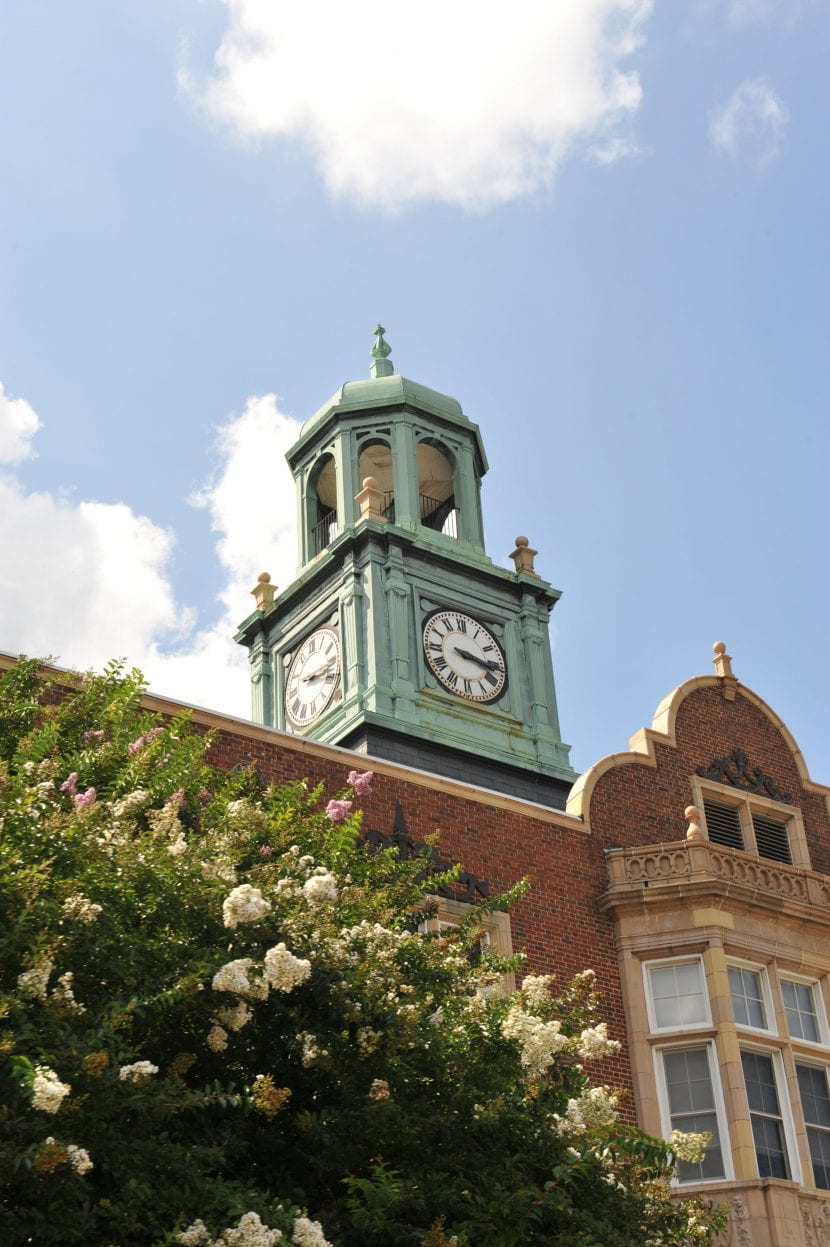After the frantic last days of the semester end and all the exams are graded, diplomas are delivered, and the dorms are packed up and cleared out, campus becomes amazingly quiet. Parking suddenly becomes a breeze. The grounds are all dressed up with gorgeous flowers but sometimes it seems the only people around to enjoy them are Kanji, kids at camp, and tour groups.
But of course, classes are still being held. In fact, for much of its 150 year history, Towson University has conducted some kind of program during the summer, and even beyond the traditional academic school day and season.
When the Maryland State Normal School (MSNS) opened its doors in 1866, it welcomed about 50 students that each county had recommended to be trained as teachers. Of course, as time went on, enrollment grew, but never was it able to keep up with the demand for teachers in the counties. This meant that not all teachers were meeting the same standards as those trained by MSNS, and so the solution was to hold “Teachers Institutes” where additional training for teachers already in place in the school system could be provided by trained Examiners.
In the 1875 Annual Report of the State Board of Education, MSNS Principal M.A. Newell writes:
So long as two-thirds of our “new teachers” every year are selected from those who have had no experience, and no training, and who can show no fitness for the work except a knowledge of the branches taught, sufficient to entitle them, in the judgment of charity, to a low grade certificate, the Institutes must be a necessity; and in order to their being efficiently conducted, the Examiners should themselves be practical teachers, fully imbued with the spirit of progress, well acquainted with all the “modern improvements” in the art of teaching, and both able and willing to train up the young teachers under their charge “in the way” they “should go.” Many Examiners of this stamp we have, and they are doing the State good service; there are others, fortunately but few in number, who could do some good – by resigning.
Eventually, MSNS no longer led the continued training of those who were already teachers, concentrating instead on the students enrolled at the school during the traditional school year from September to May.

Summer Session
With the move to the Towson campus in 1915, MSNS had the opportunity to host what it called “Summer Sessions”. Again, the
goal was to provide a space for professional development for those who were already teachers. Dormitory space was provided for the six weeks the course would run, and some children who attended the campus elementary school were “given the privilege” of attending half-day lessons during the sessions so that teachers would be able to see their work in practice.
The catalog promised there would also be “opportunities for community singing, lectures, and art appreciation demonstrations. Every Friday evening some social, musical or literary entertainment will be held. Saturdays will be devoted, as far as possible, to excursions of a recreational and educational character.”
And anyone who played a musical instrument was asked to bring it with them as “The music instructor is anxious to develop both a glee club and an orchestra during the six weeks.”
Eventually, those sessions also fizzled out, and the school again concentrated on educating new teachers, particularly as it transitioned from a teachers training school to the State Teachers College at Towson (STC) in 1935.

catching bugs and exploring the Glen in 1942.
With the beginning of World War Two, the demand for teachers increased as many veteran teachers went off to war or civil service jobs. In order to try and meet the demand, STC created an accelerated program to educate teachers in 3 years instead of 4. In 1942, summer classes were again being held on campus, and the campus elementary school students were back in session. The 1942 course catalog outlines the needs and program:
“Like many other colleges throughout the country the State Teachers College has adopted an accelerated program because of the present war emergency which has increased the serious teacher shortage in the state. A summer school of ten weeks is being held in the summer of 1942 as a part of this accelerated program and summer schools will continue to be held for the remainder of the emergency. Attendance at summer schools will enable students to complete the degree requirements and be eligible for positions at an earlier date than could be accomplished by attending during the regular session only. Freshman [sic] will be admitted at the beginning of the summer session as well as in September and February. Heretofore, freshmen were admitted in September only.”

By 1949, there was still a strong need for teachers, and summer sessions were back, but were intended “to provide for college graduates who have not had special courses in elementary education a six weeks program designed to give them as much as possible of the background, understanding, and techniques appropriate to elementary school teaching. This is not a ‘summer school’ in the regular sense of the word. It will offer one program only and will be for the one purpose stated above.”
In other words, if you had graduated from a liberal arts school in another field and wanted to be a teacher, STC’s program would help you get an “emergency certificate” without having to get a second bachelor’s degree in elementary education.
This program continued and evolved. The 1951 course catalog states “the college provides for part-time and summer study”. The summer study session remained as it had in 1949, but now “part-time study including late afternoon or evening classes for teachers on emergency certificates who wish to work toward their degrees or renew certificates.” In addition, STC student who wanted to graduate earlier could take classes, but “permission cor acceleration will be granted to only a very few individuals with superior records.”
In 1958, the first Masters program on campus included a summer program which meant that teachers could take advantage of classes while on summer break from their work.
In 1963 when the State Teachers College at Towson became a liberal arts school and changed its name to Towson State College (TSC), two titles were created within the administration: Director of Summer Session and Director of Evening Session. The aims of the program were little changed from what had been established in 1951, but the addition of evening programs opened doors for those in the work-force looking to continue their education.

The demographics TSC was aiming for seem a little narrow today.
The next year, the Summer and Evening Programs were combined into one position and TSC, already braced for an enrollment surge thanks to the post-war baby boom, continued to expand its offerings in both programs.
In 1972, TSC decided to offer winter sessions as well. Called the January Session or Minimester, it was billed in the course catalog as “a four-week term designed to offer both the student and the professor an opportunity to explore nontraditional educational experience. The subject matter is usually organized around a narrow topical theme. Both the thematic approach and the concentrated time span encourage a depth of study not possible during the regular semester. The courses offered include independent study, directed readings, practicums, travel-study, seminars and field study.”
By 1978, classes were being offered on Saturdays as well, designed for “students who are unable are unwilling to attend classes during the week, the continuing student who wishes to accelerate progress toward his/her degree, the student seeking to return after a time lapse, and the academically talented high school student.”
After the Colleges were established in 1981, the College of Continuing Studies was created and supported the many non-traditional learners that were now enrolled at Towson State University (TSU).
Today, summer, minimester, evening, and even online classes are so much a part of the fabric of Towson University, that they are no longer considered unusual.
